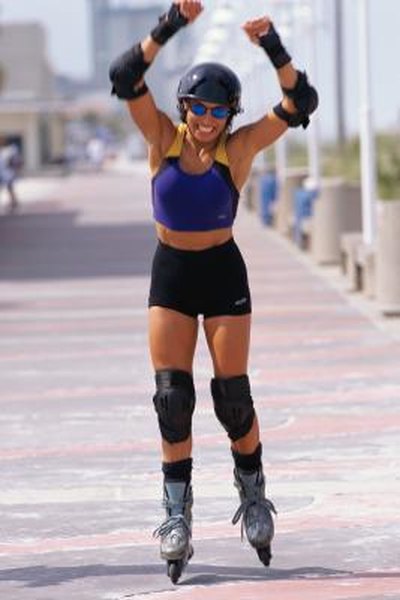
Some people inline skate for fitness without worrying about the numbers, but racers, fitness lovers and curious others are more prone to fuss about figures. This might include tracking overall speed, distance and improvements made from one workout to the next. If you're a racer or fitness-loving skater, you may be anxious to know what your "average" speeds are so you can attempt to improve upon your times. Your average speed is not so cut and dry, though, and depends on a number of factors.
Average Speeds
According to a study conducted by Rollerblade, people tend to inline skate at cruising speeds that vary from about 8 miles per hour to about 16 miles per hour. If you're on the slow end of that spectrum, you should be able to skate 1 mile in about seven minutes and 30 seconds. If you're a faster or more experienced skater on the top end of that spectrum, you should be able to skate 1 mile in about three minutes and 45 seconds. Naturally, you'll burn more calories the faster you go. A 160-pound person can burn roughly 6 calories per minute skating at 8 miles per hour and about 17 calories per minute skating at 16 miles per hour.
Factors Affecting Speed
Your skill level is the first factor affecting your speed. When you're just starting out, you might not be utilizing your leg power to its maximum and, likewise, you may not know how to glide and save that leg power for when it's needed. The skates you have can also affect your overall speed. Racing skates with wider wheels -- and often five wheels instead of four -- tend to be faster than the cheap inline skates you might find at a garage sale. The lubrication and quality of your wheel bearings can also make your skates faster. The conditions can also affect your speed; consider having the wind at your back or blasting in your face, for example. Skating in an urban environment with traffic lights and cracks in the sidewalk will also result in a slower speed than skating on a smooth, uninterrupted track or stretch of road.
Tracking Your Speed
If you're concerned about your speed, you have a number of ways to track it. On a racing track or a paved, marked trail, the simplest way to do it is to start your watch and then skate that mile, noting the time when you're done. You can also use any number of fitness apps or GPS-based trackers designed for running, biking or skating. Some apps allow you to store your previous times so that you can compare your time during one workout to subsequent workouts, helping you set goals to beat your previous times.
Safety Considerations
When you're just starting out, your focus should not be on your speed. Instead, it should be on becoming a strong, safe skater. The speed part will come later. Never skate without a helmet; it only takes one crack in the sidewalk to turn your speedy skate session into a potentially life-threatening ride. Knee pads and elbow pads can also spare your skin should you take a tumble. You should also be able to brake safely and effectively before you concern yourself with high speeds. Learn to use the heel brakes on your skates, but also the "T stop," during which you drag one skate behind you, forming a loose "T" shape with your two skates. If you're really concerned about improving your speed, join a skating club in your area or find a skating coach who can give you tips.
References
Writer Bio
Nicole Vulcan has been a journalist since 1997, covering parenting and fitness for The Oregonian, careers for CareerAddict, and travel, gardening and fitness for Black Hills Woman and other publications. Vulcan holds a Bachelor of Arts in English and journalism from the University of Minnesota. She's also a lifelong athlete and is pursuing certification as a personal trainer.



